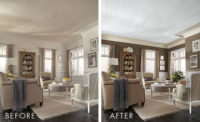Usually when someone says they’re “going gray,” it’s a gentle way to indicate they’re getting older. But in the case of structural insulated panels, when you see gray insulating foam cores on the job site, it means a new advance in the panels.
Manufacturers have produced SIPs using a variety of foam insulation cores, including expanded polystyrene (EPS), extruded polystyrene (XPS), polyisocyanurate (Iso) and polyurethane (PUR)—with EPS being the most common. Now, a new type of insulation enters the mix of options—graphite polystyrene (GPS).
Why SIPs?
Building professionals typically use SIPs for more energy efficient construction – whether required by stringent energy codes like California’s Title 24 Energy Efficiency Standards, or home and building owners’ desire to reduce energy use costs. The reason is that “SIPs do an impressive job of slowing down the transfer of heat, air, and vapor through the assembly,” explains Keith Simon, AIA, LEED AP, writing in the National Institute of Buildings Sciences’ Whole Building Design Guide.
SIPs achieve their superior energy performance in three ways:
- Providing continuous insulation across each panel’s length, width and height;
- Having far fewer gaps to seal than other wall assemblies;
- Reducing thermal bridging across structural components such as wall studs or roof joists.
The U.S. Dept. of Energy’s (DOE) Oak Ridge National Laboratory found that SIP structures are up to 15 times more airtight than stick-built walls insulated with fiberglass batts. A SIP structure’s air leakage rate was only 8 cu. ft. per minute at 50 Pascals of pressure versus stick framing with a leakage rate of 121 cu. ft. per minute. SIPs also provide substantially higher whole-wall R-values. ORNL testing showed that a SIP wall built with 3.5-inch thick EPS foam core had a dramatically higher R-value of 14.09 compared to 9.58 R-value for a 2x4 stud wall at 16-inches on center and fiberglass insulation—that’s 47 percent better thermal resistance for the SIP.
Introducing GPS Insulation for SIPs
To further enhance SIPs’ contribution to energy-efficient buildings, manufacturers have started producing the panels with GPS insulation cores. GPS is easily recognized by its gray/platinum color, which readily distinguishes it from the bright white EPS commonly used in SIPs and as insulation throughout building envelopes.
An EPS-based product, GPS insulation integrates high-purity graphite throughout the EPS polymer matrix (insulation bead). The graphite enhances the insulation’s R-value, especially as temperatures decrease. Used in SIPs, GPS insulation provides two key benefits. First, it boosts the panel’s R-values even higher—more than 20 percent higher R-values than traditional SIPs – which helps to create an ultra-high-performance building envelope. Second, in some cases building professionals can specify thinner panels while still meeting energy code requirements. This, in turn, can reduce freight costs and reduce the size and thickness of accessories such as fasteners and lumber (if needed).
Although new to the market in 2016, builders are beginning to use SIPs with GPS insulating cores in ultra-energy-efficient homes and buildings. For example, West-Eco Panels in British Columbia, Canada, has supplied Premier Platinum GPS SIPs for several Passive House projects in the province.
The next time someone wistfully mentions “going gray,” as if they should be pitied, remember that going gray can be a very good thing, as is the case with the latest advancement in SIPs.






